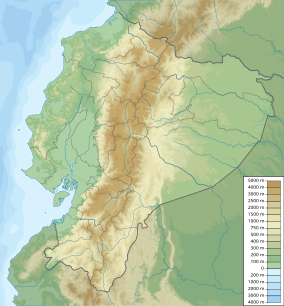Podocarpus National Park
| Podocarpus National Park | |
|---|---|
|
IUCN category II (national park)
|
|

Trees surrounding the Bombuscaro river
|
|
| Location |
Ecuador Zamora Chinchipe and Loja |
| Nearest city | Loja, Loja, Ecuador |
| Coordinates | 4°17′0″S 79°0′0″W / 4.28333°S 79.00000°WCoordinates: 4°17′0″S 79°0′0″W / 4.28333°S 79.00000°W |
| Area | 1462.8 km2 |
| Established | 1982 |
Podocarpus National Park (Spanish: Parque Nacional Podocarpus) is a national park located in the provinces of Zamora Chinchipe and Loja, in the south-east of Ecuador. It was created in 1982.
It covers 1462.80 km2, from two spurs of the eastern range of the Andes to the basins of the Nangaritza, Numbala, and Loyola rivers. About 85% of the park is in the province of Zamora Chinchipe, and the remainder is in the province of Loja. It is categorized as a megadiverse zone and an area with a high level of endemic species because it is a meeting point between four ecological systems: Northern Andes, Southern Andes, Amazonian, and Pacific. Although considerable knowledge has been gathered about its biodiversity in parts of the area, only a minority of the species inhabiting the park has been discovered so far.
The Podocarpus National Park spans from lower montane rain forests at c. 1000m up to high elevation elfin forests at 3000 m. Paramo or subparamo vegetation is found at elevations >3000 m where a complex of more than 100 lagoons exists, among the best-known being the Lagunas del Compadre.
The park has two main entrances. One is in 'Cajanuma Sector' c. 8 km south of Loja where elfin forest and paramo habitats at elevations between c. 2900 and 3500 m can be accessed. The other is in 'Bombuscaro Sector', corresponding to the Bombuscaro River in lower montane forest habitats at elevations from c. 1000 m upwards. There are two alternative entrances without park guards. The 'Romerillos Sector', corresponding to the Jamboé River southeast of the Bombuscaro Sector is also an entrance for gold miners that work inside the park. Another entrance is at Cerro Toledo, east of the Yangana-Valladolid route in the southwestern part of the park.
The park contains an exceptionally diverse flora, and has been considered the 'Botanical Garden of America'. Its high and low mountain-forest ecosystems, located in the Nudo de Sabanilla pass, and its very humid mountain and premontane forests in the basin of the Numbala River, have more than 4,000 species of plants including trees that can measure up to 40 meters, like the romerillo (Podocarpus glomeratus) which gives its name to the park, and many other valuable species like the Cinchona - the national tree of Ecuador - and a huge variety of orchids.
...
Wikipedia

